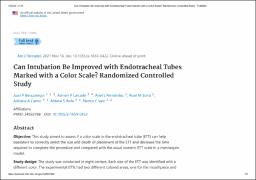| dc.contributor.author | Barazategui, Juan P. | |
| dc.contributor.author | Lacarde, Ramon. | |
| dc.contributor.author | Fernández, Ariel. | |
| dc.contributor.author | Et al. | |
| dc.date.accessioned | 2023-05-15T14:39:46Z | |
| dc.date.available | 2023-05-15T14:39:46Z | |
| dc.date.issued | 2021-11 | |
| dc.identifier.citation | Am J Perinatol . 2021 Nov 16. doi: 10.1055/a-1659-0422 | es |
| dc.identifier.issn | 1098-8785 | |
| dc.identifier.uri | https://riu.austral.edu.ar/handle/123456789/2159 | |
| dc.identifier.uri | https://www.thieme-connect.com/products/ejournals/abstract/10.1055/a-1659-0422 | |
| dc.description | Disponible en: https://www.thieme-connect.com/products/ejournals/abstract/10.1055/a-1659-0422 | es |
| dc.description.abstract | Abstract
Objective: This study aimed to assess if a color scale in the endotracheal tube (ETT) can help operators to correctly select the size and depth of placement of the ETT and decrease the time required to complete the procedure and compared with the usual numeric ETT scale in a mannequin model.
Study design: The study was conducted in eight centers. Each size of the ETT was identified with a different color. The experimental ETTs had two different colored areas, one for the mouthpiece and another to identify where the ETT should be taped above the lip (an area of 1 cm. The operators were trained as part of the protocol using an instructional video. Four clinical scenarios requiring endotracheal intubation were designed and randomly assigned. Each operator had to select the size and depth of ETT based on the birth weight (BW), and then had to perform four intubations.
Results: A total of 108 operators performed 432 intubations. No differences were found in the correct placement and selection of the ETT. Median time (in seconds) required for intubation using numeric versus experimental tube was: for ETT Ø NRP (Neonatal Resuscitation Program) 2.5, 11.5 versus 8 (p < 0.001), ETT Ø 3, 12 versus 10 (p < 0.001), ETT Ø 3.5, 15.5 versus12 (p = 0.003), ETT Ø 4, 12 versus11 (p = 0.019).
Conclusion: No significant difference was observed in the selection and correct placement of the ETT. However, the intubation time was significantly shorter using the experimental ETT. This device could improve the effectiveness of intubation by reducing the time needed to properly place the ETT at mid trachea.
Key points: · It is an innovative intervention to try to solve a great inconvenience of daily practice.. · The study also raises the difficulty in maintaining the ability of endotracheal intubation.. · It proposes a scale that ensures the correct location with a safe fixation zone..
Thieme. All rights reserved. | es |
| dc.language.iso | en | es |
| dc.publisher | Thieme Gruppe | es |
| dc.rights | Attribution-NonCommercial-NoDerivatives 4.0 Internacional | * |
| dc.rights.uri | http://creativecommons.org/licenses/by-nc-nd/4.0/ | * |
| dc.subject | Newborn. | es |
| dc.subject | Resuscitation. | es |
| dc.subject | Endotracheal intubation. | es |
| dc.title | Can Intubation Be Improved with Endotracheal Tubes Marked with a Color Scale? Randomized Controlled Study | es |
| dc.type | Article | es |


